Opuntia, a Fall Fruit
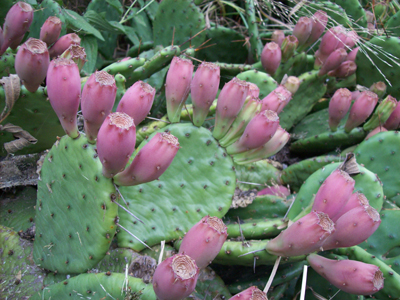
A sure sign of the approaching autumn is the annual harvest of fall fruit crops. Downtown Swarthmore eagerly displays a banner announcing their upcoming apple festival. My time at the Scott Arboretum has opened my eyes to nontraditional fruit. One such example is Opuntia. Known as the prickly pear or cactus pear, Opuntia is a member of the Cactaceae family and is found throughout the Americas. Nearly 300 species have been identified with some 104 recorded in Mexico.
Opuntia is one of several New World crops that have been cultivated since the time of the Aztec empire. The fruit, known as tuna, are still extensively grown and consumed today. One source estimates that worldwide commercial production is more than twice that of strawberries, avocados, or apricots! The vegetative pads, called nopales, are common vegetables in Central America and Mexico. Cooked or eaten raw, the taste is likened to that of green beans.
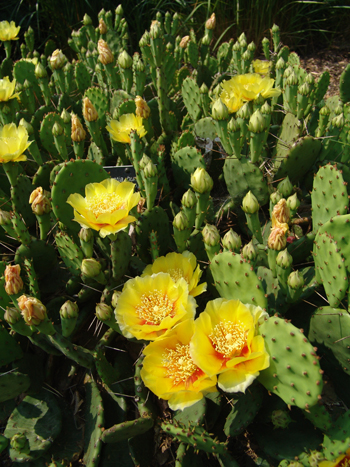
Yellow summer blooms of Opuntia humifusa. photo credit: R. Maurer
Opuntia humifusa is the hardy eastern prickly pear thriving east of the Rockies on dry, sandy soils in open pine woods, prairies and scrub. Hardy prickly pear is a spreading cactus forming 2-6 inch long oval pads. Most varieties are covered in two types of spines; large spines easily recognized from a distance, and smaller needle-like spines called glochids that grow in tufts. Bright yellow flowers occur in late spring or early summer. The pollen is highly desirable to bee populations. If fertilized, green fruits begin to form, ultimately maturing in late summer, turning reddish green. The pulp is ruby red and tastes similar to watermelon.
Opuntia humifusa is very adaptable as long as the critical requirements of full sun and sharp drainage are met. If left undisturbed, colonies can spread for yards and will grow about 2 feet tall. Prickly pear has adapted to mowers by lying prostrate and spreading outward instead of upward. Scott Arboretum makes great use of O. humifusa in the Nason Garden where it borders the walk and provides sharp visual contrast to grasses and sedges.
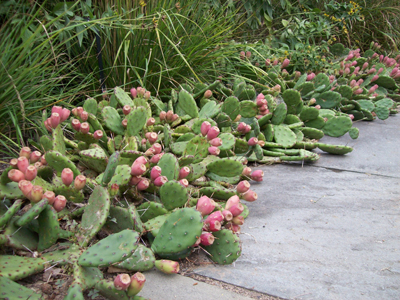
Opuntia humifusa in fruit along John W. Nason Garden walkway. photo credit: J. Coceano
Another Opuntia species found on the grounds is Opuntia phaeacantha. The tulip prickly pear is indigenous to the desert southwest and is so named for the peach colored flowers that resemble tulips. The fruits are a vibrant rose color. Opuntia phaeacantha is used to great effect in the large perennial containers at the front of Pearson Hall. Again, the contrast is perfect against the shape of Rhus aromatica and Juniperus virginiana Emerald Sentinel TM.
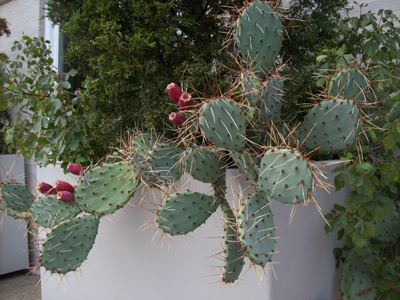
Opuntia phaeacantha in a container at Pearson Hall. photo credit: J. Coceano
Several unique environmental issues have risen regarding Opuntia. The prickly pear is used extensively as a forage crop in dry, arid regions throughout the world. It thrives on degraded soils with limited water resources. Opuntia sp. provides digestible energy, water, and vitamins. Other energy sources must be supplemented, as the cactus lacks in protein. Cattle and humans are the primary consumers. Spiny varieties must have the spines removed, usually by burning, before feeding.
Restoration projects have found the genus useful in the prevention of soil erosion and to combat desertification. A lesson is to be learned from introducing non-natives. Opuntia has become weed-like in several countries where no natural enemies exist. Biological controls, as well as best management practices, have been successful in controlling Opuntia.
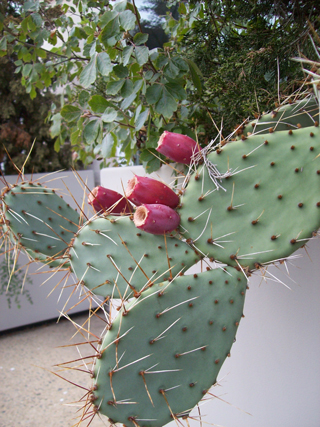
Fruit of Opuntia phaeacantha. photo credit: J. Coceano
Given our summer of extreme heat, humidity, and limited precipitation, I have come to admire the amazing adaptive capabilities of the prickly pear. Added to its tough as nails demeanor are beautiful flowers, which support insect populations, edible fruit, and a unique shape all of which add up to a plant worthy of inclusion in ones garden.





lynne McCartney
Posted at 20:04h, 29 NovemberThe Opuntia is also important and meets some of the nutrients required for the desert tortoise.
This should be must in your garden if you have a permit, and own a desert tortoise/s. To the best of my knowledge Opuntia is also great for the Sulcata tortoise, and probably more tortoise varieties. I own both Sulcata and California desert tortoises and purchased an Opuntia (prickly pear) upon purchasing my first after reading it’s value. Keep your pets happy and healthy. Also replicate
their habitat as close as possible.